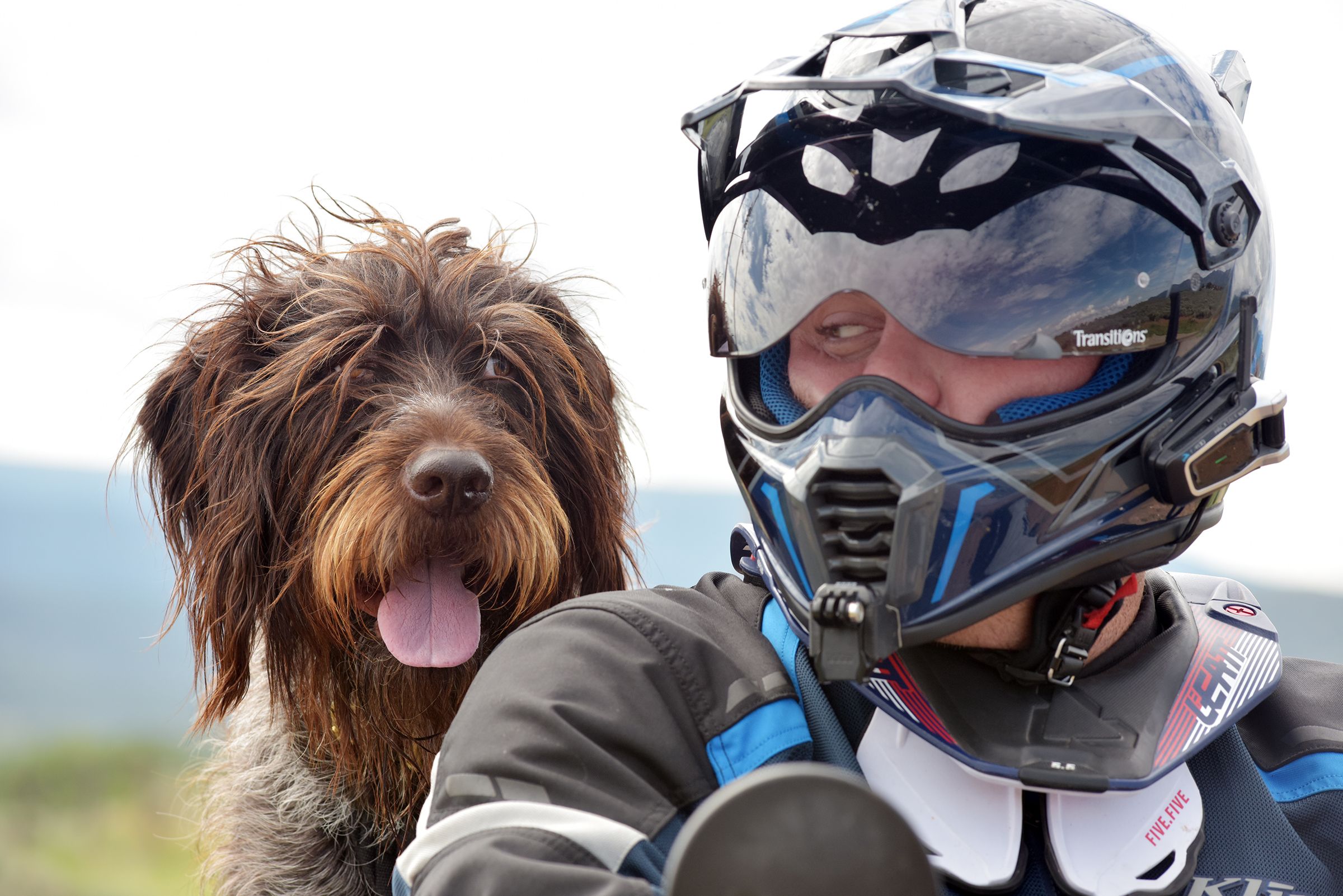Walter gets a little nervous when Reid Hobby isn’t around. The 4-year-old Deutsch Drahthaar doesn’t much like being without his human companion. “He’s a social dog,” Hobby says. “Actually, he’s like a leach. He’s the Robin to my Batman. He sticks to me like glue.”

Walter has ridden shotgun in every vehicle Hobby has ever owned, and until last year, there was only one territory left to explore: the 2021 BMW 1250 GSA Reid bought during the summer of that year. Reid, who lives with the black and gray German wire-haired dog on a farm in Newberry, South Carolina, decided he didn’t want to travel without his canine companion, so he began his search for a product that would allow Walter to safely ride on the adventure bike.
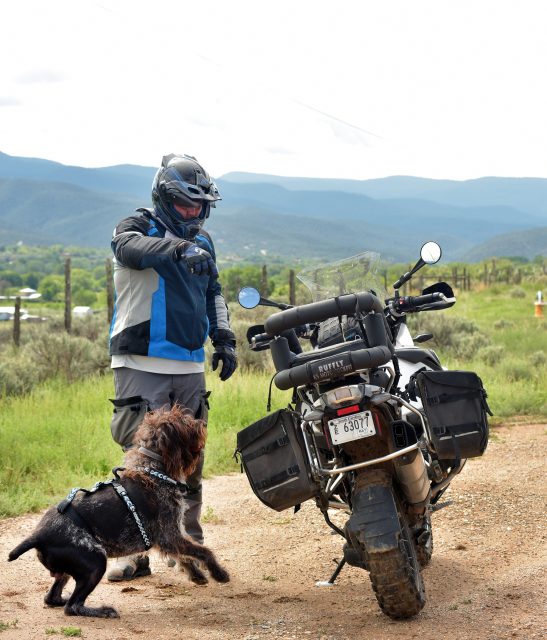
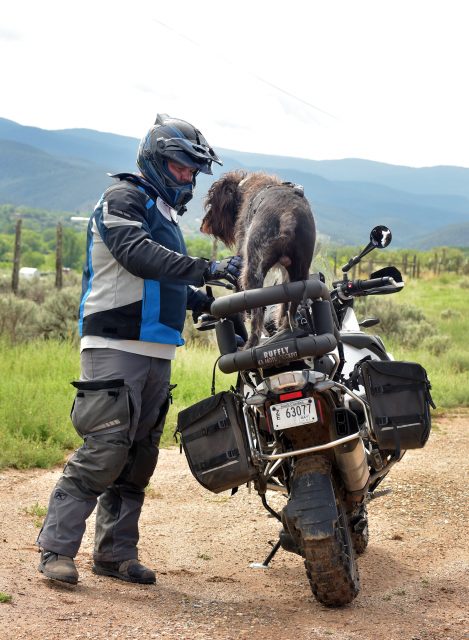
“After an endless train of Google searches, I found GoRuffly,” he said.
As far as she knows, owner Jess Stone is the only creator of custom motorcycle dog carriers, designed to offer both comfort and safety to canines who wish to adventure with their humans. The K9 Moto Cockpit is sized to each dog and built to mount on any motorcycle. It also comes with custom upholstery and personalized embroidered text.
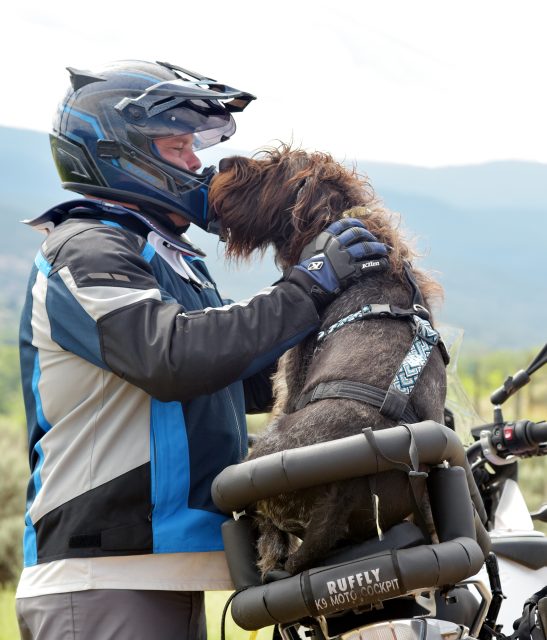
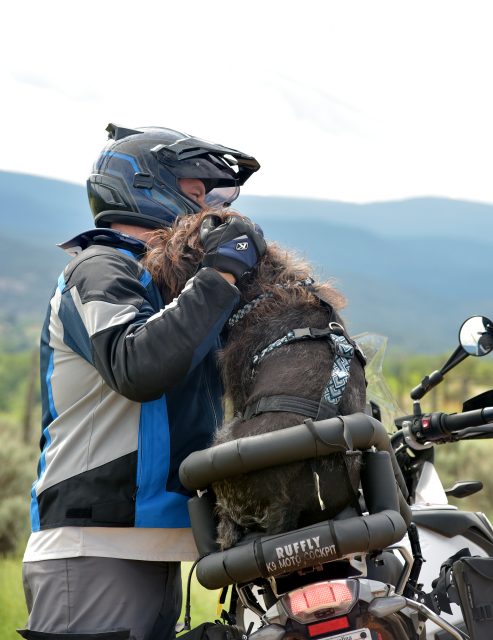
“People have always taken their dogs camping and adventuring, but until now, it has been difficult in the moto industry to find a comfortable and safe means of transporting your pet,” Stone says. Stone is currently traveling from her Guatemala home on a world motorcycle tour with her beloved German Shepherd, Moxie.
Reid, an engineer, made a few modifications to his carrier, which is a perfect fit for Walter. “As soon as I got it mounted, he hopped up on it and was ready to go.” So fond of the carrier is Walter that he barks now whenever Reid gets ready to ride. “Outdoors people like pets, and outdoors people like to travel,” Reid says. “And they like to travel on bikes. All Walter and I need is a fly fishing rod and a tent. We hang out. We ride bikes. We explore. Bikes are freedom, and dogs are freedom. What could be better?”
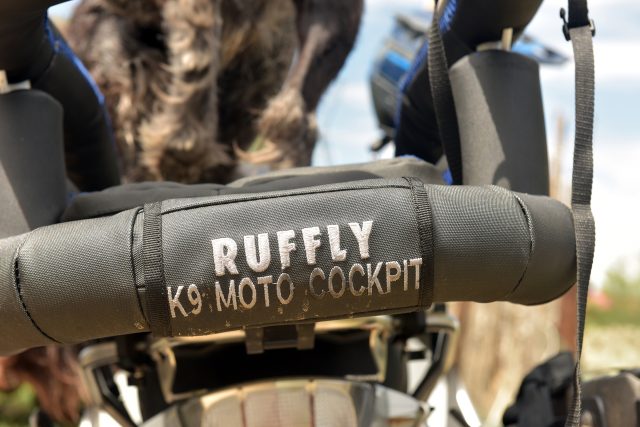
The statistics
So far, there are no statistics on the safety of canine transport via motorcycles, but the trend is strong enough that some unusual moto products—such as dog helmets—are making their way onto the market.
“We don’t support the helmet theory because it’s really all just a novelty,” says Beth Simon of Madisonville, Kentucky, who three years ago created the social media group Motorcycling with Fido to swap information and raise awareness of pet safety when on a motorcycle.
Beth has been riding with her dog, Ryder, a rescued 4-year-old terrier/feist mix, since he was a pup, and will soon train her other two dogs, both rescues and Chihuahuas, to ride on her Can-Am Spyder F3. “Ryder is a lunatic. He’s very whiny because he was taken from his mother at four or five weeks, so he rides in a front pack. We haven’t done the thousands of miles that other folks have, but when I started this group, I had questions. I wanted to know if I could do it or what I needed to do it. I needed information.”
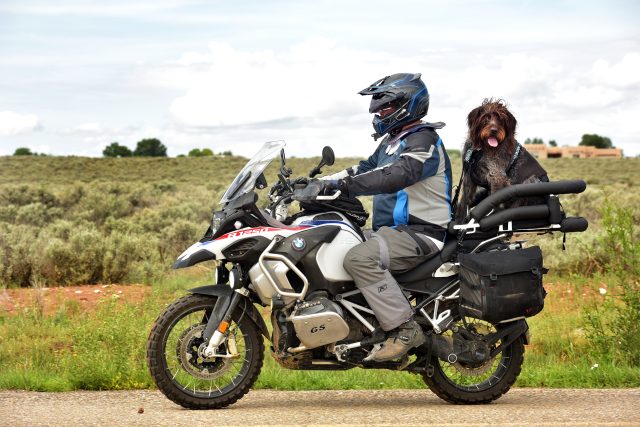
Nearly 4,000 members later, Beth administrates the page with a little help from her friends, and the dog-loving motorcycle enthusiasts keep coming in droves. “They come with pictures, and they come with answers.”
The DIY’ers
A trip-through page posts reveal just about every type of canine carrying concoction imaginable on every bike and nearly every riding condition. Some use sidecars, and others use tents, boxes, makeshift carriers, frontpacks, and backpacks. They ride everything from Street Glides and BMW GSs to KTMs and Royal Enfields. Some ride street, some dirt, some camp, some hotel it. They offer advice, tips, and lessons learned. One rider advises putting the dog in a top case for a few months before riding, creating a cozy home in it, and providing treats. “When they get used to the fact that you can zip the cozy home as well and nothing bad happens, put the top case on the bike.” Another rider offers, “Buttercup started in a pet carrier I mounted to my Sportster. Then I upgraded to a tour pack that had the top cut out. She rode with me for countless miles … Buttercup was a natural-born biker.” Other posts offer information about doggles (goggles for dogs), vests, harnesses, and tethers. And, without a doubt, they share photos of their beloved pets.
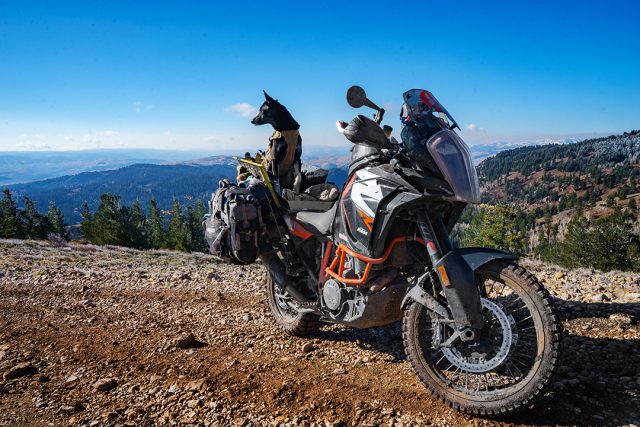
Ash Chestnut, a self-described full-time nomad, puts his dog, Derby, in a backpack when he rides his Yamaha WR250R because the ride is too bouncy in a top case. “We all know what happens with plans, so if I come across something with a risk I might drop the bike, I stop and take her out of the backpack, walk her past the obstacle, and tether her so she’s safely out of the way,” he says. “I clear the obstacle, then she’s back in the backpack, and we’re on our way.
“We’ve done the TAT, CDT, CABDR south, WYBDR, and Colorado San Juan passes,” Ash says. “Anywhere I go, she goes, and has for more than six years now.” On his street bike, he adds a bandana to keep her ears from flapping so much in the wind. On that bike, she rides in a top case.
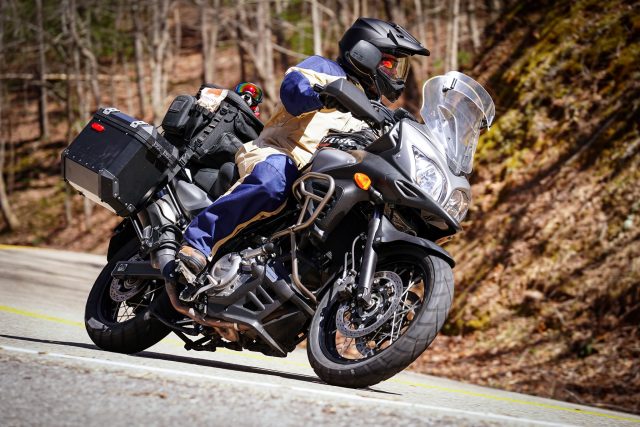
Beth says she gets accused of censoring the Motorcycling with Fido social page, and she admits she’s quick to delete photos and posts that could potentially harm pets, such as dogs being tethered to motorcycles by their collars. “There have been no studies—a lot of opinions but no studies. When we get accused of censorship, we do push back. We have veterinarians in the group. We can only recommend what we feel is in the best interest of the dog.”
The group maintains information files, like how to build your own pet carrier, with safety features in mind like correct harnessing and venting. “We get pictures of people with dogs in laundry baskets. Don’t use laundry basket. That’s for laundry,” Beth says.
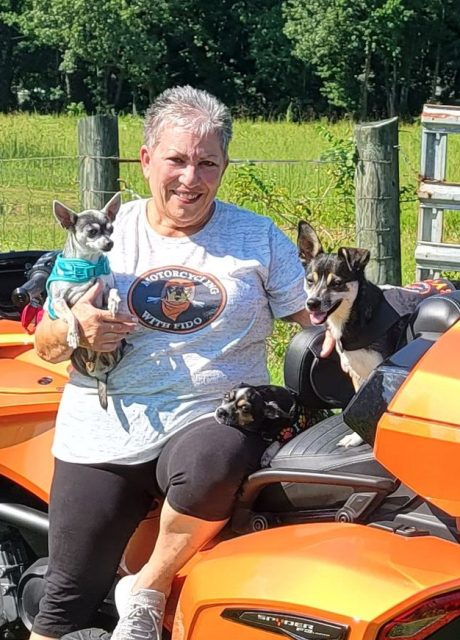
Like many of the page’s members, Odessa Winter and her partner, Scott Canto, built their first motorcycle dog-carrying rig four years ago when their rescued German Shepherd mix started riding. Back then, Surak was only a puppy. Fifty-two pounds later, the couple has traded the task of driving Surlak on their adventures, which are mostly dirt. She rides a KTM 690 Enduro; he rides a Yamaha Ténéré 700.
“We’re going to do a nice fall tour of the US, head up to South Dakota and then Wyoming before heading to Utah,” Odessa says. When Surlack first started riding, they placed him in a pannier, and Odessa would ride pillion next to him. “We did small rides down the road or around the block,” she says. “He got used to how it felt and got used to the noises.”
As Surlack grew, so did the carrier. The current one is designed with an aluminum and steel frame and composites for the sides and the back with surfaces on which Surlack can rest. And now, Surlack has gotten so good at riding that he leans with the bike in turns. “He hops up there himself. He lines up for it and gets a running start,” Scott says. “Any time we’re outside near the bikes, he comes out and lines up.”
Making it your own
Odessa said they opted not to tether their pet so that he could get away quickly if something went wrong. “We went back and forth on tethering for a couple of years because we ride a lot of trails, and we don’t want him to be trapped on the bike,” she says. “If the bike should slide off a ridge, he would go where the bike goes, or even in traffic with cars. We felt it was the safest thing to do for the dog. We worked really hard on designing this carrier to prevent him from falling out.”
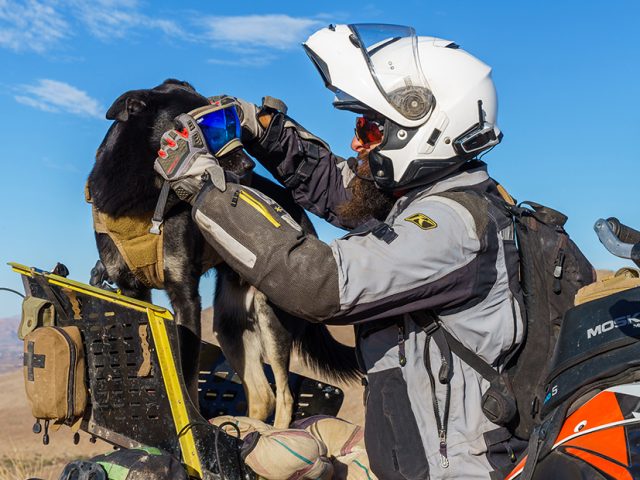
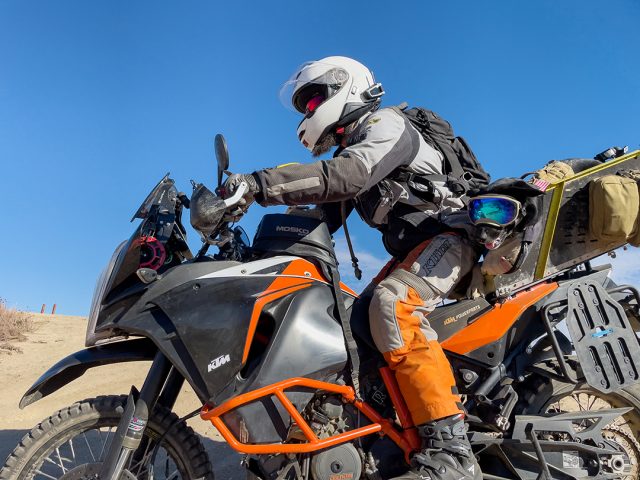
Obedience training was a big part of teaching Surlack to ride. “He won’t pursue anything, a squirrel or another dog,” Odessa says.
The couple says motorcyclists considering riding with pets need to closely examine what’s required. “It looks cool, and it’s neat and super rewarding, but it’s also a massive responsibility,” Scott says. “Much of what we do is driven by the dog, what trails are acceptable, if it’s too hot or too cold. He’s black and roasts in the heat. But even the decision on what bike to ride is driven by the dog.”
And then, there is the usual stuff adventures are laced with. Take, for example, the couple’s recent trip to the New Mexico BDR. On Section 6, Odessa got a flat tire, then a hydraulic leak in a fork. “It was a terrible sequence of events,” Scott said. “We put a tube in there, and at that moment, the pump decided to die.”

She rode the remaining 40 miles at 15 mph on a flat tire to get to an Albuquerque mechanic. They resolved the tube and tire situation, but the fork seal situation would have to wait. Since they were due at the Mountain West Overland Expo in Loveland, Colorado, in a few days, they opted to limp the bike north and have the seals changed there. Still, the dog’s safety was at the forefront of the journey.
“I would encourage anyone who wants to take your dog to remember your dog is not an accessory,” Odessa says. “This is an extremely vulnerable passenger.”
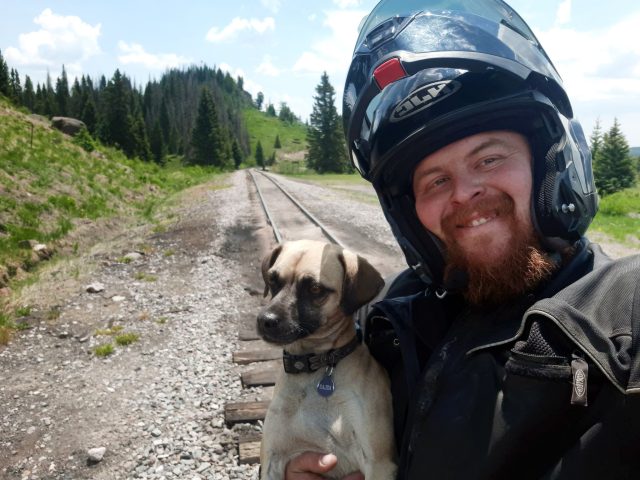
Willie Nelson has a 3-year-old puggle (pug/beagle mix) named Atlas, who has been riding on his KTM 1190 Adventure bike for about a year and a half now. He and his wife, who live in Big Bear Lake, California, began watching instructional videos when Atlas jumped on the back seat of one of their motorcycles without being prompted. “Every time we grabbed our helmets, she would get very excited,” Willie says. “We had to figure out how to bring her with us.” The couple made a DIY carrier from a luggage piece Willie had found on the internet. “I cut a small piece of plastic from a storage container and put a rubber hose around it to secure it. We did a couple of rides around the block, and she just fell in love with it.”
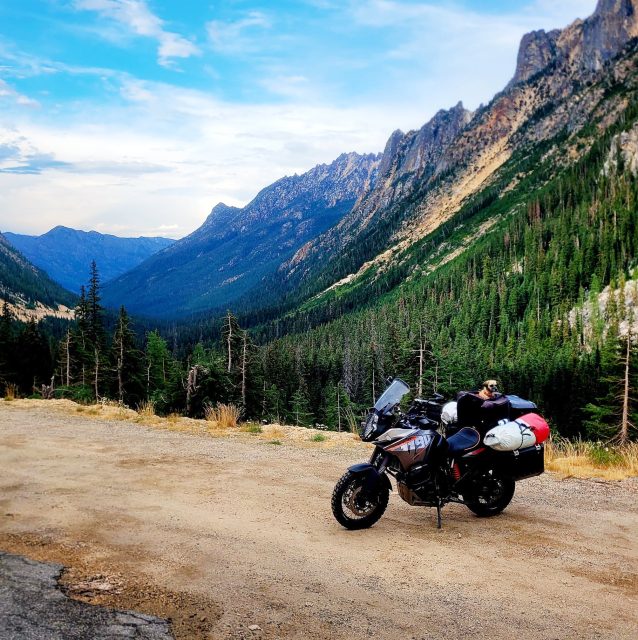
They have since modified the bag with a bed and air intake, making hot rides more comfortable for the dog. On a ride through Death Valley, when it reached 118°, the couple put ice packs under Atlas’ bedding. “With the air being forced past the ice, she actually had air-conditioning, and I was struggling in the heat,” Willie says. “But her longest day so far was 900 miles, and as long as she stops for a break and to eat, she’s a very easy travel companion.”
Like this story? See Ashley Giordano’s piece on Jess Stone’s GoRuffly here.
Our No Compromise Clause: We carefully screen all contributors to ensure they are independent and impartial. We never have and never will accept advertorial, and we do not allow advertising to influence our product or destination reviews.


